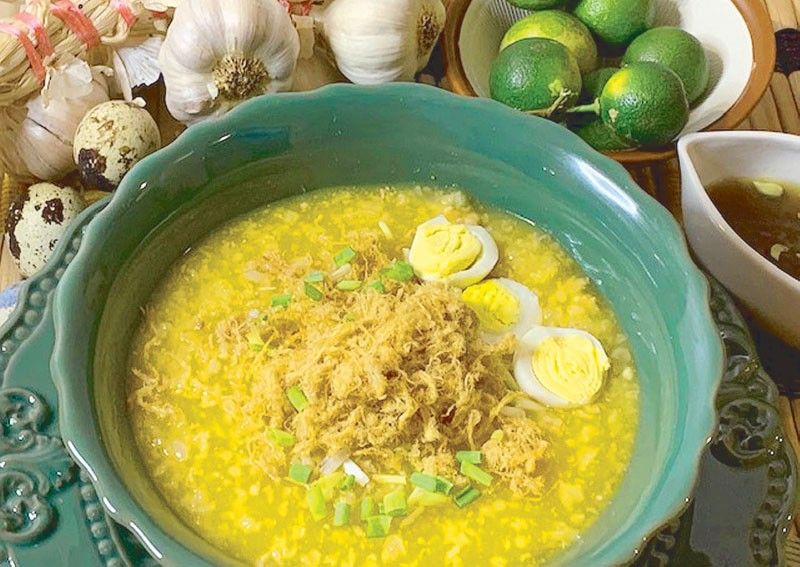Congee: Comfort food for rainy days

I was seated on a plane on the way home from the U.S. when I heard a passenger near me ask her companion, “What is congee?” She was looking at the inflight menu, which the flight attendants were soon to serve. Her companion didn’t know what congee was, either, so I volunteered to tell her that congee is rice porridge.
It was the probably the best and shortest way to describe this Asian dish: rice cooked to a soupy consistency in a large amount of water or broth. When properly cooked and served with a variety of toppings, this rice porridge can be very satisfying.
Indeed congee is, for me, as it probably is for many others, a real comfort food. I used to order it sometimes in Chinese restaurants, but when my sister Cory gave me a recipe for it, I’ve since cooked it at home instead.
Cory got the recipe from a Chinese friend in Sydney, where she lives. The recipe uses glutinuous or sticky rice, rather than ordinary rice. That’s probably what differentiates it from plain lugaw. Because it’s sturdier, sticky rice can absorb more water and can withstand longer cooking than ordinary rice, keeping the grains from becoming mushy.
And because congee is served with various toppings, it elevates lugaw to a higher level. In fact one can probably describe congee as lugaw with attitude.
In Sydney Cory often cooks congee for her grandchildren (of which she now has five). It’s just right on cold winter nights, and for a quick lunch or dinner. One of their favorite toppings is century eggs, but because century eggs are not readily available here, I use hardboiled quail eggs instead.
In fact, because I’ve cooked this dish so often, I’ve decided to add innovations of my own. Aside from the quail eggs, I put other toppings such as pork or chicken floss (available in Chinese stores and sometimes in Aji-Ichiban), fried garlic and, when feeling particularly indulgent, I’d sprinkle it with grated chicharon. I also add some achuete oil. This turns the congee a vibrant orange color, making it look more appetizing.
Here’s the recipe for congee. Now that the “ber” months are here, congee is perfect on cold, rainy nights. Make sure to serve it piping-hot.

Extra-special congee
Ingredients:
1/2 kilo ground pork
1/3 cup oyster sauce
12 – 14 cups water (and more as needed)
2 chicken broth cubes
2 cups malagkit (sticky) rice, washed well then drained
1 - 2 tablespoons patis
For the achuete oil:
1/4 cup cooking oil
2 tablespoons achuete seeds
For the toppings:
12 quail eggs (or as much as desired), hardboiled
1 – 2 cups pork or chicken floss (store-bought)
Chopped fried garlic
Chopped green onions
Fresh calamansi
Patis
Procedure:
In a bowl, mash the ground pork with your hands or with two spoons to break apart the chunky parts. Pour the oyster sauce over the ground pork, mix well and marinate the pork for one to two hours.
In a stockpot or deep casserole, pour in the water and add the chicken broth cubes. Bring to a boil. When the water starts boiling, pour in the washed rice grains. Let boil, then lower heat to a simmer. Let simmer over medium heat, stirring occasionally, until the rice is half-cooked. If the mixture becomes too thick, stir in more water.
Meanwhile, in a skillet, heat the cooking oil and sauté the achuete seeds. Let cook until the oil turns a bright orange color. Remove from the heat and strain the oil through a sieve or strainer into a clean bowl. Discard the achuete seeds and set aside the oil.
When the rice becomes half-cooked, add the ground pork. Season with patis. Continue simmering until the rice and the pork are fully cooked. Keep adding more water if the congee becomes too thick, stirring occasionally.
When the rice and pork are fully cooked, pour in the achuete oil. Stir well, until the congee becomes an even, bright orange color.
Ladle into individual bowls and top each bowl with the quail eggs, pork or chicken floss, fried garlic and chopped green onions. Serve hot with calamansi and patis.



















